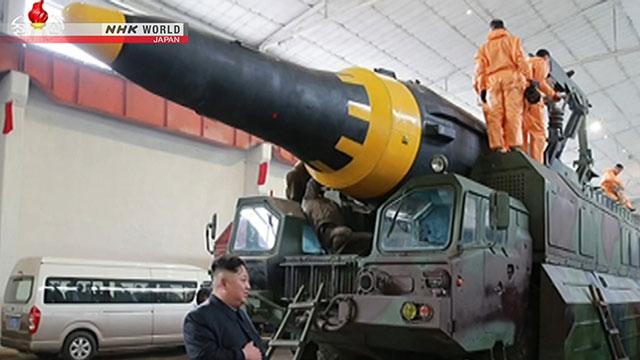State media said earlier the missile was fired at a sharp angle and hit its target nearly 800 kilometers away after flying to an altitude of over 2000 kilometers.
The broadcast also showed pictures of leader Kim Jong Un supervising the test. Kim reportedly warned the US that it will not escape the biggest disaster in history if it attempts to provoke his country. Security expert Yu Koizumi of the Institute for Future Engineering says the photos released by North Korean state media show a drastic improvement in its missile technology.
North Korea is calling its missile a Hwasong-12. Koizumi agrees. He says it poses a threat to the Asia-Pacific region.
"Sunday's missile is said to be able to fly 4,500 kilometers. I think it's an intermediate-range ballistic missile aimed at hitting targets in Guam. In order to make that possible, North Koreans added new technology, designing a new type of missile."
"This is a typical liquid fuel blast. When solid fuel is burnt, smoke rolls up in billows. But as you can see, relatively clear flames shoot out of the missile," he continues. "Liquid fuel has a structure that's more complicated than solid fuel so it's more cumbersome to handle, but its performance is a lot better."
Koizumi explains, "Take a look at how the flames come out. You can see the main engine's flame in the middle. On both sides of the main flame, you see some thin flames. That's the result of firing what's called vernier engines. They're used for attitude correction to reduce air resistance. In the past, North Korea had been trying to stabilize its missiles with little wings at the bottom. But now the country is using vernier engines. It's a sign of technical progress."
Koizumi also explains why he thinks the missile was launched using a "lofted" trajectory -- shooting up at an altitude of over 2,000 kilometers.
"Fired at a higher vertical angle on a lofted trajectory, a missile will come down at a very high speed, exposing the warhead to extreme heat. If North Korea was to attack the US mainland with a missile, it has to travel a very long distance and its warhead would be exposed to extreme heat. You have to think that with Sunday's launch, the country tested how it performs under those conditions."
While Koizumi doubts North Korea's latest technology is fully operational, he says the launch was a success and is a considerable step towards the development of an intercontinental ballistic missile capable of reaching the US mainland.
